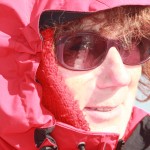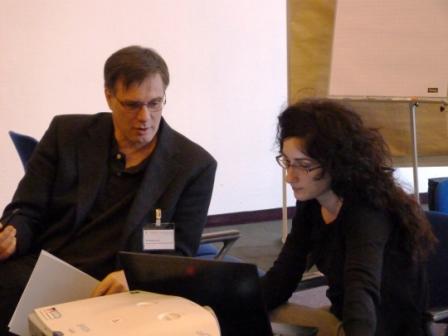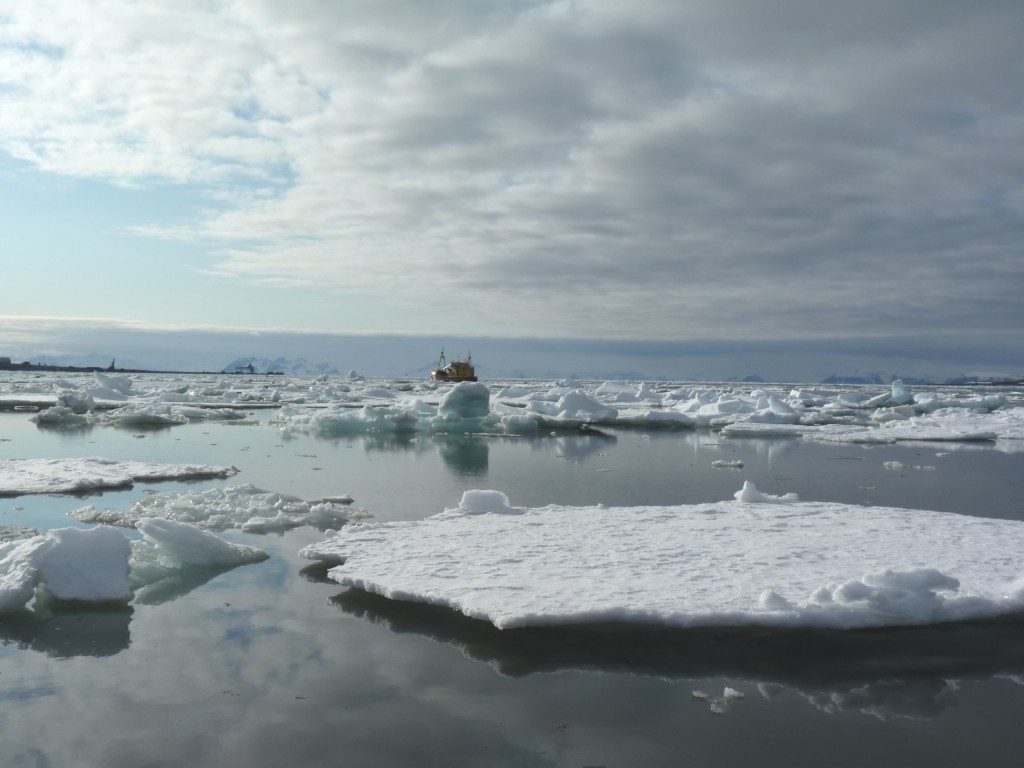Search Results for Tag: science
The “big Greenland melt”
- Melting Ice off Greenland.
Just recently I interviewed a scientist who told me he assumed last year’s record melt in Greenland was a one-off thing and not necessarily a result of climate change. Or rather, he said, it was impossible to say until we see whether it actually happens again. Given that the Greenland ice sheet is the biggest ice mass in the northern hemisphere and would also have a huge impact on global sea levels if it melts, it is encouraging to know that a huge effort is going on to find out exactly what is happening.
Ice Blogger’s gallery on climate change in Greenland
Audio feature on climate change in Greenland (Irene Quaile, for DW)
Tim Radford of Climate News Network has just published an article on the subject, with an excellent overview. He quotes scientists from Sheffield, UK, who have come up with a new theory. This is what Tim has to say. I quote at length, as it such a good summary of what has been happening and the possible explanations so far. Thanks Tim Radford and Climate News Network for drawing our attention to the latest research and filling in so much background. Over to you:
“First: the story so far. For a few days in July 2012, almost 97% of the surface of Greenland began suddenly to thaw. This was a melt on an unprecedented scale.
Greenland carries a burden of three million cubic kilometres of ice and even in the summer, most of it stays frozen, partly because of the island’s high latitude and partly because ice reflects sunlight, and tends normally to serve as its own insulator.
The event was so unusual, and so unexpected, and on such a scale that nobody seriously suggested that the dramatic conversion of snow to slush was direct evidence of climate change because of human-induced global warming.
Soot, smoke and heat
At first, climatologists were inclined to see the thaw as a consequence of the record-breaking heat waves and forest fires that afflicted North America last summer: snow could have been darkened by columns of soot and smoke from forest fires, just enough to start absorbing the sunlight, some reasoned.
Then in April a team at the University of Wisconsin-Madison suggested that freak cloud behaviour over Greenland at the time might have caused the melting. Clouds normally block sunlight and keep the terrain below them cool.
But these clouds could have been thin enough to let solar radiation through, but thick enough to trap the consequential infra-red radiation from the ground, and raise the local temperature levels.
Now Edward Hanna and colleagues at Sheffield report in the International Journal of Climatology that they have another explanation. Unusual atmospheric circulation and changes in the jet stream – the same changes that almost washed away summer in England – sent a blister of warm air sweeping over the ice sheet.
Hanna and his team analysed all the weather data collected by the Danish Meteorological Institute and by US researchers, and then employed satellite readings and a computer simulation called SnowModel to reconstruct the strange turn of events. And climate change may after all be a suspect.
High melt years
The Greenland Ice Sheet is a highly sensitive indicator of regional and global change, and, says Prof Hanna, been undergoing rapid warming, and losing ice, for at least the last five years and probably the last 20.
“Our research found that a ‘heat dome’ of warm southerly winds over the ice sheet led to widespread surface melting.” This was not predicted by the climate models used by the Intergovernmental Panel on Climate Change, and perhaps that indicated a deficiency in those models, he suggested.
The event seemed to be linked to changes in a phenomenon known to oceanographers and meteorologists as the summer North Atlantic Oscillation (NAO), another well-observed high pressure system called the Greenland Blocking Index, and the polar jet stream, all of which sent warm southerly winds sweeping over Greenland’s western coast.
“The next five to 10 years will reveal whether or not 2012 was a rare event resulting from natural variability of the NAO or part of an emerging pattern of new extreme high melt years.” It was hard to predict future changes in the Greenland climate in the current state of knowledge, but important to keep on trying.
There is an awful lot of ice on top of Greenland. Once it starts to melt, it is likely to be, say the Sheffield scientists, “dominant contributor to global sea level change over the next 100 to 1,000 years.”
Tim Radford, Climate News Network, 18.6.2013.
The Ice Blogger is heading off for a short break. Back July 8th, with new ice and snow pictures, I hope!
Climate impacts should spur emissions curb
- Professor Wolfgang Lucht and Ioanna Mouratiadou at a session on “What’s still missing” to address climate impacts
Here in Potsdam at the Impacts World 2013, I have been searching for the links between climate impacts research and political action to curb emissions. I have talked to a lot of the scientists present from different parts of the world about this, both in the sessions and one-to-one. My concern is that the increasing focus on adaptation to cope with the effects of climate change could detract from awareness of the need for urgent political action. Professor Wolfgang Lucht , who’s in charge of Earth System Analysis at the Potsdam Institute for Climate Impacts Research PIK) and Professor of Sustainability Studies at Berlin’s Humboldt-University told me he thinks the very opposite is the case. He is convinced the evidence being amassed on the impacts of climate change will strengthen the case for stricter emissions targets. He is convinced better networking of the available data will help provide politicians with the material they need to get on with both mitigation and adaptation.
Cynthia Rosenzweig is head of the Climate Impacts Group at the NASA Goddard Institute for Space Studies. She says Hurricane Sandy was a kind of “tipping point” in awareness of the possible effects of climate change and the links to extreme weather events. She had been advising the city of New York on climate for 15 years before that. The interest, unsurprisingly, has intensified considerably.
She is also pushing very hard for better linking of different models, especially relating to the future of agriculture, and ultimately food security for the future. She introduced the conference to “AgMIP”, not a really catchy acronym, but easier than “The Agricultural Model Intercomparison and Improvement Project”. This whole conference is moving around better integration of information, better links and networks. The image of the “food web” came to me, which replaced the old “food chain”. Models at global level, domestic, regional, local, scientific bodies, ngos, governments, local authorities, have to be woven together to pool their knowledge – but in such a way that individual actors can access the info they need. A challenge indeed. There are also those here who say global scientific climate models have little relevance to adaptation to the effects of climate change on the ground. I am with Professor Lucht, who says we need the global models and the two degree target as a framework for the rest.
Climate Impacts World in Potsdam
- Artist in residence makes a visual summary of the discussion.
Potsdam, around half an hour from Berlin, is the home of the Potsdam Institute for Climate Impact Research (PIK), which has become one of the world’s leaders in its field. This week , the Institute is co-hosting “Impacts World 2013”, an “International Conference on Climate Change Effects”, along with the International Institute for Applied Systems Analysis.
I suppose you could describe climate impact research as a kind of bridge between climate science and what it means for the rest of us.
Droughts, floods, health risks, crop failures – there seem to be few areas of our lives where climate change does not have an impact.
There is a whole myriad of climate models, using different parameters and scenarios and focussing on different sectors. The ambitious aim of this gathering is to bring scientists and decision-makers together to try to understand how different sectors relate to each other and find ways of “joining the dots”..
Let me just share a couple of insights or thoughts with you that I picked up in the course of the day.
We need to bring the mass of information together in ways that make it possible for society to be prepared for extreme events and to cope with changing availability of water, different growing conditions, coastal erosion, sea-level rise.
Global trends in temperature rise are one thing – the impacts on the ground will be very different in different parts of the globe. Fitting the parts of the jigsaw together is a huge challenge.
Scientists themselves (this is based not only on the official sessions but conversations in the coffee breaks) are often confused by the differences in climate models and predictions. Slight changes to parameters can lead to hugely different results.
Feeding information from impact researchers “on the ground” back into models seems highly desirable but does not always happen.
There has been a lot of talk about communication. Some scientists think their job is to “do science”, not communicate with politicians or the public. Others want to communicate but are not very good at it. Some are very good at it and appear frequently in the media. My colleague Fiona Harvey from the Guardian, who chaired a debate on “Are the products of climate impact research really useful?” argued that all scientists should communicate their knowledge and not leave it up to a talented few. Otherwise, those who make the headlines may not be the ones who represent the consensus view. Indeed!
The media came in for a lot of stick as usual. We do have a huge influence and with it, a huge responsibility to get things right. My appeal to the scientific community – please do not put us all in the same boat. Not all of us are out to find sensations and just headlines that will attract the most attention whether they are accurate or not.
That is why I will head back into the conference and listen to more talk of the “Inter-sectoral impact model intercomparison project”, “Community-driven syntheses of climate change impact analyses”, “projection of global soil carbon dynamics”, “global multi-model perspectives on the potential and limitations of irrigation…” with the ultimate aim of finding out more about the impacts of climate change on or societies today and tomorrow. Then I will continue to try to explain it to those who rely on the media for relevant information in words they can understand…
Arctic melt worries UN and White House
The UN weather agency WMO (World Meteorological Organisation) has confirmed that the Arctic’s sea ice melted at a record pace in 2012, the ninth-hottest year on record. With just 3.4 million square kilometres (1.32 million square miles) during the August to September melting season, the sea ice cover was a full 18 percent less than the previous low set in 2007. The WMO’s Secretary-General Michel Jarraud said this was a “disturbing sign of climate change”, and pointed to the link between climate change and extreme weather events.
Meanwhile, a special briefing was called at the White House to discuss the possibility of the Arctic becoming ice free in the summer within just TWO years. Nafeed Ahmed, director of the “Institute for Policy Research & Development” headlines his post for the “Guardian“: “White House warned on imminent Arctic ice death spiral”. He describes the meeting, including NASA’s acting chief scientist Gale Allen, the director of the Department of Homeland Security and the Pentagon as “the latest indication that US officials are increasingly concerned about the international and domestic security implications of climate change”.
10 Arctic specialists were called in to advise the US government, including marine scientist Professor Carlos Duarte, currently director of the Oceans Institute at the University of Western Australia. I met and interviewed Prof. Duarte back in 2011 at the Arctic Frontiers conference, when he worked with the Spanish Council for Scientific Research. At that time, he was already calling for urgent action and warning of the danger of “climate tipping points”, including the melt of the Arctic sea ice. His conclusions are based on research which was presented in an article in Nature Climate Change last year.
The West Australian newspaper quotes Prof. Duarte as saying the “snowballing situation would prove as hard to slow down as a runaway train”. He told the paper the ice melt was accelerating faster than any of the models could predict, and the prospect of an Arctic Ocean free of ice had been brought forward to 2015, compared with a prediction in 2007 that at least a third of the normal sea ice extent would remain in summer in 2100. When I spoke to him in 2011, the US navy was already assuming a date of 2050 and Duarte said he expected it to be even earlier.
Professor Carlos Duarte on Arctic Tipping Points
Prof Duarte also warned of the increasing danger of melting methane. Let me quote a little from the interview:
DUARTE: “We know from the history of ice covering the planet along geological time scales that ice is strongly a non-linear element in the earth’s system. It’s one of the components that show very rapid, very abrupt changes and tipping points. So we expect that once the ice will be lost quickly from the Arctic and also from the shelves in Greenland, then other forces will be set in motion, and many forces will be set in motion by loss of ice. One of them is the release of methane hydrates from the shallow continental shelves, mostly around Siberia, and those are molecules of methane that are trapped into ice in the sediments of the continental shelves and in the permafrost on land. So if this ice melts, this methane can be released abruptly and suddenly. And deposits of methane trapped in the shallow sediments of the Arctic amount to about five times the greenhouse power that humans have set in motion through burning fossil fuels. So if this five times what we have released in 150 years is released within a few years, that would be detrimental to the climate system and it could lead to a very rapid warming, and could again set in motion other forces like increased freshwater discharge to the Arctic, which has already increased by 30 percent. And this involves a greater export of fresh water and buoyancy to the Atlantic, which may affect global circulation and global currents, and those in turn will affect regional climates also further south to the sub-Arctic region. Also, warmer temperatures are leading to dieback of the boreal forest and also the peat deposits in the boreal region are drying up to the extent that they can catch fire.”
(IRENE QUAILE: How close are we?)
DUARTE: “We very much know what the threshold and the tipping point for the release of methanes will be, because the methane is kept in the hydrates, deposits in the salty sediments by ice, frozen sediments, and we know the freezing point of salty sediments may be around minus 1 degree. So when the temperature of water in the summer goes well above freezing point, the hydrates will defrost and the methane will be released. So what we need to monitor is the temperature of the shallow waters in the Siberian shelf and other shallow waters in the Arctic, in the Canadian region as well, and see how close they’re getting to temperatures of 3 and 4 degrees, which will be those that will lead to melting of the hydrates.”
Scary? The interview, it seems, is as relevant as ever, the Professor’s warnings more urgent. I wonder what it feels like to be called in to the White House to brief the government of a country that is both a key player in the Arctic and a top emitter of the greenhouse gases that are causing the melt? On the one hand it must be satisfying for the scientists to know they are finally being heard. But there must also be some frustration about the extent of dangerous climate change that had to be set in motion first. Has the Arctic ice already reached a “tipping point”?
Let me close with another quote from that interview with Carlos Duarte:
DUARTE: “Unfortunately society is much more mobilised by opportunities than by risks. So the discourses and warnings of risks actually almost lead to inaction by society, whereas the sight of opportunities encourages society to set themselves in motion. So the opportunities for economic growth in the Arctic have dominated the discourse and the actions by society and policy makers. Those opportunities are new navigation routes across the Arctic, and the exploitation of oil, gas and fisheries, that were not accessible just a few years ago. The paradox in this is that the Arctic countries recognise that the forces that are improving access to these resources is actually climate change and that the reason for this climate change is the burning of fossil fuels by humans. Arctic nations themselves are responsible for 26% of the release of these greenhouse gases and are taking advantage of these opportunities, which will involve greater emissions of greenhouse gases. (…) I think there should be a balance between the economic growth these opportunities could bring about and the economic losses, they may bring about, which I don’t think have been quantified.”
Antarctic Peninsula is thawing faster
Ice in parts of the Antarctic Peninsula is now melting during the summer faster than at any time during the last thousand years, according to new research results. The scientists have reconstructed changes in the intensity of ice-melt, and the mean temperature on the northern Antarctic Peninsula since AD 1000, based on the analysis of ice cores.
According to the study, published in the journal Nature Geoscience, the coolest conditions and lowest melt occurred from about AD 1410 to 1460, when mean temperature was 1.6 °C lower than that of 1981–2000. Since the late 1400s, there has been a nearly tenfold increase in melt intensity from 0.5 to 4.9%. The warming has occurred in progressive phases since about AD 1460, but the melting has intensified, and has largely occurred since the mid-twentieth century. The study concludes that “ice on the Antarctic Peninsula is now particularly susceptible to rapid increases in melting and loss in response to relatively small increases in mean temperature”.
Paul Brown of Climate News Network says the findings explain a series of sudden collapses of ice shelves in the last 20 years, which scientists studying them had not expected. He also quotes the researchers as saying the current melting could lead to “further dramatic events, making the loss of large quantities of ice on the Peninsula more likely, and adding to sea level rise”.
The study is also of interest against the background of the debate going on over the last 20 years on whether the Antarctic would gain mass through extra snow falling and so REDUCE sea level rise, or would lose ice because of higher sea and air temperature and so exacerbate the effect.
The scientists use a 364-metre ice core from James Ross Island to get in insight into both past temperatures and ice melt. Layers in the core show periods when summer snow on the ice cap thawed and then refroze. By measuring the thickness of the layers, they could tell how the history of the melting related to changes in temperature at the site over the last thousand years.
Lead author Dr. Nerilie Abram of the Australian National University and the British Antarctic Survey (BAS) said: “Summer melting at the ice core site today is now at a level that is higher than at any other time over the last 1,000 years. And whilst temperatures at this site increased gradually in phases over many hundreds of years, most of the intensification of melting has happened since the mid-20th centrtury.
Dr. Robert Mulvaney from the BAS, who led the drilling expedition and co-authored the paper said: “Having a record of previous melt intensity for the Peninsula is particularly important because of the glacier retreat and ice shelf loss we are now seeing in the area. Summer ice melt is a key process that is thought to have weakened ice shelves along the Antarctic Pensinsula leading to a succession of dramatic collapses, as well as speeding up glacier ice loss across the region over the last 50 years”.
The changes on the Antarctic Peninsula do not necessarily apply to other parts of Antarctica, such as the West Antarctic ice Sheet. Melting is also occurring there and could have an even greater risk of large-scale sea level rise.
Paul Brown from Climate News Network notes “it is not clear that the levels of recent ice melt and glacier loss in West Antarctica are exceptional or are caused by human-driven climate changes.”
Lead author Abram says: “This new ice core record shows that even small changes in temperature can result in large increases in the amount of melting in places where summer tempearatures are near to 0°C, such as along the Antarctic Peninsula, and this has important implications for ice instability and sea level rise in a warming climate”.
I interviewed Andrew Shepherd, Professor of Earth Observation at the British University of leeds, on a major satellite sutdy of the polar ice melt towards the end of last year. It makes interesting listening to complement this latest development:
Interview with Andrew Shepherd
See also:
Polar ice sheets melting faster than ever
Are warming seas changing the Antarctic ice?
Photo gallery: High season for Antarctic researchers



























Feedback